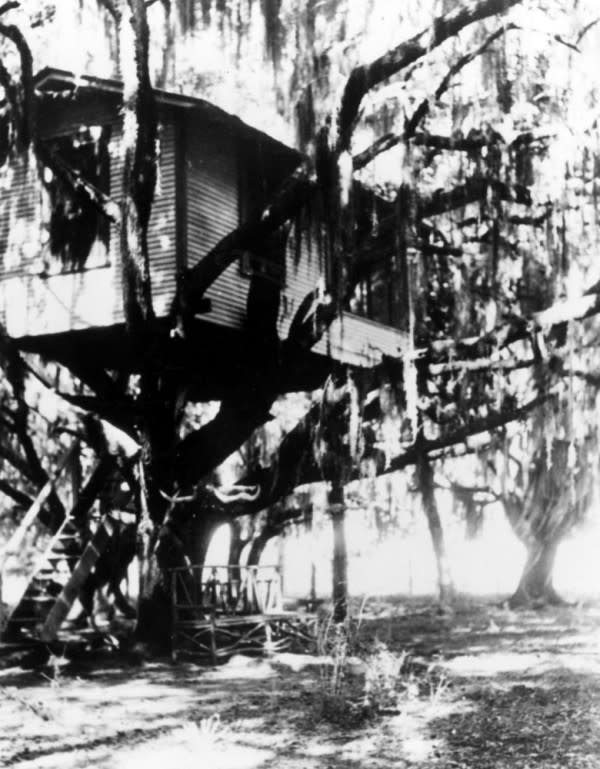Vintage Sarasota: Step Inside the Tucker Treehouse

Jesse H. Tucker had the right idea when he built his Upper Myakka Lake cabin 15 feet off the ground. Perched in the branches of a live oak tree, the refuge was well above most flood waters that frequent the Myakka River area. The two-room tree house was dedicated as "Jes Tuck Up" on April 22, 1934, when Tucker's mother broke a bottle of swamp cabbage juice against the supporting tree. The ceremony was one of a number of activities at the 52nd anniversary party for Tucker's parents, Mr. and Mrs. F.H. Tucker Sr.
"Jes Tuck Up" was built of cypress. Its two rooms were bedrooms, one of which was closed in, the other screened. A ground-level shed and barbecue stand under the tree accommodated other camping activities. On six fenced acres, the campsite included an artesian well, croquet and horseshoe pitching grounds, as well as a baseball diamond for use in dry weather. The large live oaks, some trunks of which were four feet in diameter, provided extensive shade.
The Myakka River area has long been a favorite spot for campers. An early account, Wild Life in Florida, was written by Englishman F. Trench Townshend in 1875 based on his experiences while hunting around the Myakka lakes. He described the quick construction of a palmetto hut, for which a cross timber would be attached to two poles for trees. Then large cabbage palm leaves would be positioned slanting out from the cross timber and down to the ground. The resulting shelter could protect three or four campers from the rain and the sun. The shelter was no protection from mosquitoes, however, which were especially prevalent in the swampy areas. Ocelot, raccoon, opossum, deer, alligator, turkey, quail, duck, snipe and wild pig were typical products of their hunting expeditions.
After Bertha Palmer arrived in Sarasota in 1910 and purchased thousands of acres in the area, she built a camp near the Upper Myakka Lake. It served as a retreat from the business that often engaged her when at home and traveling. The cabins continued to be used by other members of her family after her death, often as the center for hunting parties. Once the area was acquired by the state of Florida for the Myakka River State Park, the Civilian Conservation Corps built a number of cabins for campers wanting something a bit more sophisticated than a palm-roofed hut for sleeping.
While the camping huts and Tucker's tree house are no more, the CCC cabins remain and the campgrounds of the park continue to be in great demand for those looking for a retreat from the busyness of life along the coast.
Special thanks to Ann Shank, former Sarasota County Historian, for her research and time to develop this article. Brought to you by Sarasota History Alive - Where history happens everyday! www.sarasotahistoryalive.com



